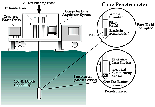

An enhanced cone penetrometer has been developed that can reliably penetrate the coarse sands and gravels characteristic of arid environments. Over the past two years, the VOC (Volatile Organic Compounds) Arid Integrated Demonstration, sponsored by DOE's Office of Technology Development, has been working with Applied Research Associates to modify, test, and deploy this instrument. This cone penetrometer technology (CPT) offers a rapid, cost effective, and safe alternative for collecting geophysical and contamination data. The technology can save considerable time and money by minimizing the number of wells required for testing. CPT has been successfully demonstrated and deployed at DOE's Hanford, Washington site and is being tested and will be deployed at Fairchild Air Force Base in Spokane, Washington.
 The cone
penetrometer is a geotechnical tool designed to rapidly penetrate soil and
continuously collect geophysical and contaminant data. It has
been used for approximately 50 years in geotechnical applications, but
its use in environmental restoration is relatively new. The CPT
was developed primarily for use in soils with sands, silts, and
clays which a hydraulically driven 1.5 inch metal rod could easily
penetrate. The tip of the rod can collect soil moisture, temperature,
soil conductivity, and contaminant data. However, the use of this tool
in arid environments where soils tend to have gravel and cobbles,
has been limited. The standard cone penetrometer did not have the weight, balance,
or hydraulic power to push through these materials when they were encountered
and the 1.5 inch rod and the penetrometer tips and sensors
weren't designed to withstand the forces inherent in penetrating arid soils.
In soft soils the CPT can penetrate several feet per minute, a
rate significantly greater than standard drilling methods, with
little secondary waste generation. It can advance through
fine-grained soil at a rate of 40 to 50 feet per hour.
The cone
penetrometer is a geotechnical tool designed to rapidly penetrate soil and
continuously collect geophysical and contaminant data. It has
been used for approximately 50 years in geotechnical applications, but
its use in environmental restoration is relatively new. The CPT
was developed primarily for use in soils with sands, silts, and
clays which a hydraulically driven 1.5 inch metal rod could easily
penetrate. The tip of the rod can collect soil moisture, temperature,
soil conductivity, and contaminant data. However, the use of this tool
in arid environments where soils tend to have gravel and cobbles,
has been limited. The standard cone penetrometer did not have the weight, balance,
or hydraulic power to push through these materials when they were encountered
and the 1.5 inch rod and the penetrometer tips and sensors
weren't designed to withstand the forces inherent in penetrating arid soils.
In soft soils the CPT can penetrate several feet per minute, a
rate significantly greater than standard drilling methods, with
little secondary waste generation. It can advance through
fine-grained soil at a rate of 40 to 50 feet per hour.
In September 1991, Applied Research Associates conducted tests in the 200 West Area at the Hanford Site to evaluate the feasibility of using existing CPT. This area is characterized by 70 to 90 meters of gravel/cobble soils. Thirteen penetration tests were conducted at eight locations. The CPT achieved depths greater than three meters in six of the tests, each at a different location. The maximum depth reached was 20 meters. Modifications to the CPT truck were made by ARA to increase the depth capability and the viability of the system. The pushing capacity of the truck was upgraded from 20 to 35 tons, its balance was adjusted, the rod diameter was increased to 1.75 inches, and the conical tips of the penetrometer rod were replaced with harder material. Testing was continued in 1992, and the average depth of penetration increased by a factor of three to 62.5 feet, with a maximum depth of 147 feet.
The tip of the cone penetrometer rod can be as great as two inches in diameter. It is pushed hydraulically into the ground with a maximum pressure of 60,000 pounds. The hole generated retains the outside diameter of the rod, and can be grouted as the probe is withdrawn to seal the hole and prevent the escape of contaminants. As the rod progresses into the ground, a computer reads data from sensors located both in the tip and the side of the probe. The cone penetrometer can monitor for contaminants as the probe is advanced, or can leave monitors in place as the rod is withdrawn. The CPT can also be used to install small diameter wells through cobble/gravel geologic media to depths of more than one hundred feet. This allows quicker and cheaper installation of vapor extraction and injection wells in the vadose zone. These wells can also be used for pump-and-treat or sparging scenarios, and may be able to provide chemical and radiological readings from the subsurface. The cone penetrometer can collect several types of data as well as groundwater samples. Decontamination fluid is the only waste generated.
![]()